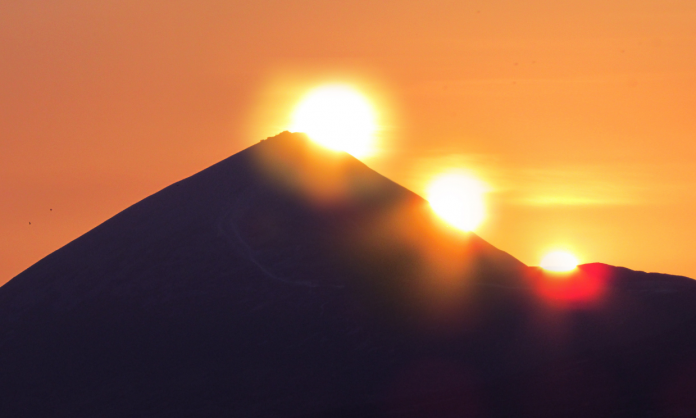Those of us who would like to go but will be unlikely to ever attend Newgrange on Winter Solstice and who end up being disappointed with the recordings, broadcasting and online streaming of the annual event should consider a “sunny alternative” spectacle. Discovered by the late Gerry Bracken in the 1980/90s, this phenomenon is not as widely known as its County Meath counterpart but just as astonishing.
Located in an East-South-East orientation in relation to Croach Patrick, The Boheh Stone, which is also known as “St Patrick’s Chair” is located in the townland of the same name, Boheh, near Brackloon, Co. Mayo on the N59 and approximately 5 miles outside Westport. Over 250 carved markings can be found carved into the surface of this large rock, depicting shapes described in the archaeological sense as cups, cup and ring and keyhole motifs. This piece of rock art, which is rare in Ireland and so far the only example west of the Shannon dates back to the Neolithic period.
Per definition by the Heritage Council: “However, alongside … famous megalithic art tradition, which is associated with monuments, there is a lesser known form, that of open-air Atlantic rock art. The term Atlantic rock art was popularised in the 1990s by the archaeologist Richard Bradley and refers to a carving practice widespread across Atlantic Europe. This art is found in Ireland, Scotland, England, France, Spain and Portugal, a range of approximately 1,800km. Unlike megalithic art, rock art is typically found on boulders and outcrops. This Atlantic tradition dates to the Later Neolithic/Early Bronze Age period (circa 3000-1500BC).”
While it is not clear what the carvings represent and whether they were initially indentations in the rock by natural causes and then adorned by Neolithic people, they remind me personally of the Bedolina “Rock Map” found in northern Italy. Upon further studies of the stone, the archaeologist Michael Gibbons together local historian Michael Moylan discovered another panel of carvings in 2014.
One theory is that the petroglyphs were created in the image of the above mentioned “sunny spectacle’, named “The Rolling Sun”, discovered by the late Gerry Bracken. He had worked in the area and noticed that on particular dates the sunset in the background of Croagh Patrick resembles the golden ball of the sun “rolling down” the north shoulder of the mountain (search for visuals on the internet). The best dates to observe this phenomenon are 18th-19th April and 22nd-24th August at sunset. While the April date may have served as an early type of calendar/reminder to the neolithic dwellers to start the planting season, the August date may be a predecessor to the “modern day” Lughnasa.
Guided tours are available from the relevant tourism organisations in the local area and are announced online. So, should you travel to Mayo in search of the “Rolling Sun”, don’t forget to bring eye protection and don’t look straight into the sun as this may damage your eyes.
Thank you Gerry Bracken for sharing this with us.








